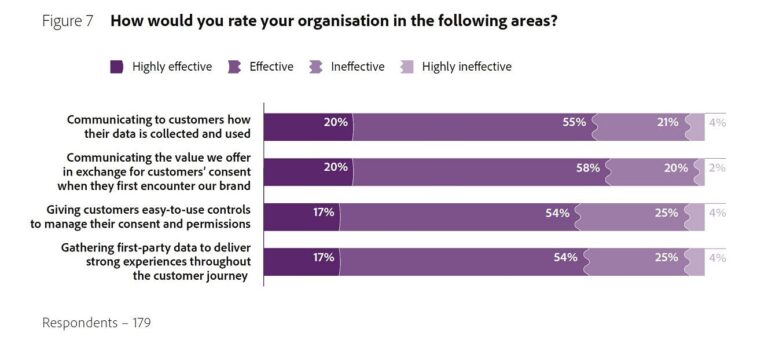To get the initial opt in, the survey found that “immediate value” topped the list among 35% of global respondents, whether in the form of discounts or loyalty rewards. Tied in second place at 25% for motivators to opt-in were alerts for shipping, delivery, or curbside pickup, as well as receiving order confirmations or receipts. Gaining early access to big sales events was the third most popular reason at 21%.
First, start thinking like a customer. Get your head on straight when it comes to empowering consumer control. Don’t approach privacy grudgingly, but rather, take it on as an act of stewardship. Embrace what customers want, knowing they’ll appreciate your understanding and reward you for it. Represent your customer’s needs every day and in every way.
Tell us about your role – what does a typical day look like for you?
Third, build experimentation and customer feedback into your daily operating model. No one knows exactly how customers will respond to anything these days, so stop guessing and do the work required to know what’s actually effective.
What makes a great mobile app experience in your opinion?
At the same time, consumer expectations for privacy and control will continue to increase, along with government mandates for protections. The demise of third-party data means brands must focus on creating direct customer relationships and facilitating a mutual exchange of value. Companies that embrace consumer privacy will discover they’re building sustainable competitive advantages with each interaction.
Looking ahead, there’s no question that mobile apps will be at the centre of the customer experience. Brands that get great at managing app experiences will out-perform those that don’t. And while there are a number of best practices for mobile apps today, those practices will continue to change as customer expectations evolve. Brands that become complacent will quickly find themselves out-manoeuvred by hungry competitors.
My advice is simple in concept, but difficult to put into practice. It involves three ideas.
What are the factors that prompt consumers to opt in, and conversely, leads them to opt out when it comes to marketing communications via SMS, email marketing, and mobile app notifications?
Airship has been a leader in Mobile App Experience (MAX) management since before the concept existed. Today, our investments in innovative solutions demonstrate that we know more, care more, and do more to help brands succeed in this space than any of our competitors.

Personalisation is one way to achieve this, but without a system for creating and adapting native app experiences at scale, you won’t really get where you want to go. Such a system, which we call a Mobile App Experience Platform, must enable business users to (1) grow customer understanding, (2) solicit customer feedback, (3) test alternative tactics and app UX for continuous improvement, and (4) optimise every stage of the customer journey on an app — from acquisition and activation, to engagement and loyalty.
We’re going to continue doing what we’ve always done – delivering value to businesses who want to effectively manage mobile app customer experiences. In practical terms, this means investing in talent and resources to help companies, and continuing to innovate technologically.
Mobile apps have never been more important to the customer journey than they are today. Recent research by Klarna found that nearly 70% more UK consumers now shop using their mobile devices compared to before the pandemic. Nearly two-thirds use the retailer’s app while shopping in stores.
Thomas Butta is Chief Strategy and Marketing Officer for Airship, the mobile app experience platform. We ask him what makes a great mobile app experience, and learn about why marketers should have what he calls a ‘life after download’ mindset.
How might a mobile-first strategy impact customer loyalty?
That’s why a “life after download” mindset is so important. Creating customer experiences that offer true value and engage customers on their terms is what ultimately drives loyalty.
My days are filled with conversations involving people all around the world, conversations designed to help our customers solve problems. There is literally never a dull moment. Our team operates in a hybrid model, which means we work from wherever we happen to be and we’re available 24/7. To perform at that level, I have to take care of myself. I try to get a good night’s sleep. I eat well and exercise daily. And maybe most important, I don’t procrastinate. I’ve seen too many people fail because they put off dealing with tough issues. When something needs to be handled, I handle it. Now.
Our work shows that customer experience trumps transactional promotions any day. And that means providing valuable experiences in moments people are engaged with the app. In practical terms, marketers need “no-code” approaches that can empower their teams and accelerate performance improvements. “No code” means developers get to focus on the next set of market-differentiating app features. And the app and brand teams gain more ownership over mobile app experiences.
What advice would you give to a marketer in your industry right now?
Second, make sure your teams – both marketers and developers – are focused on life after download. Make work easier for all your people with solutions that can be executed using low- and no-code approaches. That’s the only way your teams will be able to deliver the added value you want and need.
Apps have become a preferred destination for consumers and the centrepiece of brand loyalty. Apps are where the exchange of value between customers and brands is most respected and rewarded.
Consumers have more control than ever over their data and can easily shut down brands that aren’t meeting their needs. They want and expect mobile-enabled conveniences and personalised service, which offer a valuable opportunity to build insights that maximise personalisation and conversion. Successful brands will continue to build out first-party and zero-party data.
Finally, the effectiveness of email will continue to erode. Inboxes are overflowing, and email is a cognitively heavy consumer experience. Our survey of 9,000 global consumers found that half of all people always or often ignore emails from brands to which they’ve subscribed, while 3 out of 4 people ignore emails at least half the time or more.
How do you predict marketing will evolve in the next 12 months?
In doing so, our aim is to continue to help brands move beyond their reliance on development resources and cyclical app updates so they can drive innovation that rewards customers. We want to enable brands to treat their mobile apps as high-value destinations where they can cultivate an open and reciprocal value exchange.
Here’s a simple truth: If the experience and content offered within an app doesn’t resonate with a customer, they will leave the app without making a purchase and never come back. All that work you put into getting a customer to download can turn out to be useless – and expensive!
A recent global consumer survey we conducted revealed that 40% of global respondents say they are more likely to continue receiving brand communications if they are given controls over purpose, frequency, and channel.
Instead of focusing on continuously fine-tuning app experiences, these brands treat their app as just another messaging channel. That’s not surprising since all they get from SaaS platforms are channel messaging solutions.
Finally, what’s next for Airship?
But it’s not enough to get a customer to download an app. That’s why we’re so focused on what we call “life after download.” It’s the only way to optimise the app experience all the way through to loyalty. Mobile app experience – MAX – needs to be engaging and add value through the customer journey. And a focus on MAX means a focus on the entire customer lifecycle, with more and better performance every step of the way. Better data. Better onboarding. Better personalisation. Better experiences. More effective experimentation.
Once customers get to the app, brands remain massively reliant on developer resources and app updates to improve experiences. The result? App user retention rates have barely budged over the past several years, despite ongoing growth in annual worldwide app downloads.
Many brands do a good job acquiring customers and convincing them to download the app and register their email, but then they fall into what we call the “chasm of no return.”




![Paid Social Cyber Week: Top 4 Last-Minute Tips [Video]](https://research-institute.org/wp-content/uploads/2022/04/paid-social-cyber-week-top-4-last-minute-tips-video-768x432.png)

